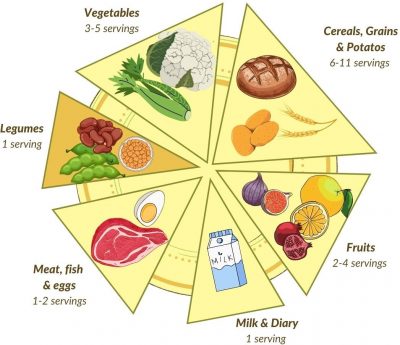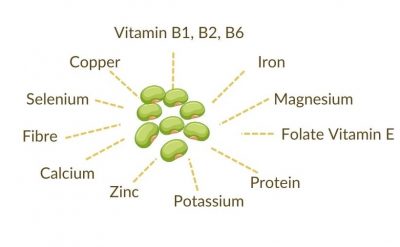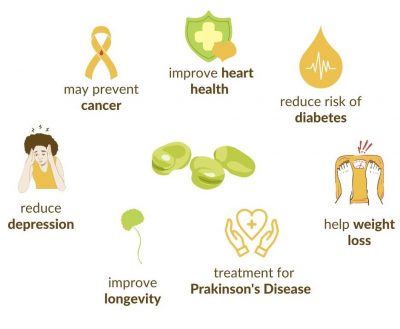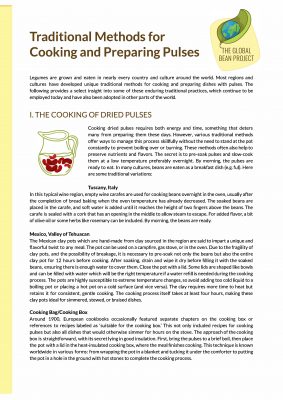Pulses like beans, peas, lentils and chickpeas are a simply delicious, naturally nutritious food. Because of this, most national and international dietary guidelines recommend eating more pulses. The suggested amount varies between at least one portion of 25 g dry/80 g cooked pulses per day – as in Portugal – up to 3 cups (720 mL) in the US per week.
The Planetary Health Diet by the EAT-Lancet Commission, which constitutes an optimal diet for the health of humans as well as the health of our planet in terms of environmental sustainability, recommends 75 g (dry weight) of pulses every day.

healthy dietary guidelines
This actually fits the amount of legumes eaten daily by the people in the Blue Zones. The Blue Zones are five regions worldwide, which were identified by scientists for the extraordinary longevity and health of its residents.
What makes pulses so healthy?
Pulses are mostly known for their valuable plant-based protein, but they are also high in fibre, complex carbohydrates as well as in vitamins and minerals. Increasingly research is revealing the wide-ranging effects of the nutritional value of pulses on our health and even the prevention of diseases. Pulses such as beans, peas and lentils are also low in fat.
THE NUTRITION FACTS OVERVIEW

Plant-based Protein
- Pulses contain between 21 to 25%, lupins and soybeans even up to 40% protein by dried weight, which is much higher than other sources of vegetable protein.
- Regular eating of pulses provides a good source of protein at a low cost compared to animal protein sources, and can be used as a climate friendly meat alternative.
- By eating pulses together with grains (as in many traditional dishes, e.g. lentils with rice, beans with corn, etc.) the amino acid content of the proteins complement each other very well.
Complex Carbohydrates
- The majority of the calories in pulses come from carbohydrates in the form of starch, resistant starch (digested by beneficial bacteria in the gut), and small amounts of non-starch polysaccharides (also digested by beneficial gut bacteria).
- Being rich in complex carbohydrates, and rich in fibre, pulses have a low glycaemic index. This makes them an ideal food for the management of insulin resistance, diabetes and hyperlipidaemia.
- Pulses contain complex sugars called oligosaccharides, which are non-digestible, fermentable fibres. They are broken down by beneficial bacteria in the colon, which may result in gas production and flatulence. With the regular consumption of pulses the gut will benefit and digestive problems will disappear.
Beneficial Dietary Fibre
- Pulses are rich in both soluble and insoluble fibres.
- Soluble fibre traps dietary cholesterol inside the digestive tract. The cholesterol is then excreted versus being absorbed, which helps to lower blood levels of LDL cholesterol, especially if LDL cholesterol levels were high to begin with. LDL is low-density lipoprotein cholesterol, which is also called “bad” cholesterol,
- Pulses also provide substantial amounts of insoluble fibre, which help attract water to the stool. This may help to combat constipation, colon cancer, and other digestive health conditions.
- Second meal effect: The second-meal effect is a concept first announced in 1982 by the developer of the low-glycaemic index diet, Dr. David J. Jenkins of the University of Toronto. Dr. Jenkins defined the second-meal effect as the effect the first meal has on the blood sugar level after eating the second meal. Foods that contain fibre-rich legumes keep the blood sugar levels relatively constant and so the blood sugar level spike, that could occur after the second meal is avoided. This effect is the result of viscous substances in the fibre that slow down the digestion and absorption of the sugars. Therefore diets that contain fibre-rich pulses improve the blood sugar control of the next meal and regulate insulin release better than low fiber diets.
Essential Vitamins and Minerals
- Potassium: Most pulses are good sources of potassium, a mineral that promotes healthy blood pressure levels.
- Pulses contain copper (important for blood and nerve cells), phosphorus (growth process, as well as the maintenance of bones and teeth), manganese (production of several enzymes and antioxidants), and magnesium (needed for muscles and nerves to work properly) —nutrients that many people do not get sufficiently through their regular diet.
- Iron: Most pulses are a rich source of iron, which makes them important for vegetarians and vegans, who do not get an animal source of iron. Without sufficient iron, there aren’t enough red blood cells to transport oxygen, which leads to fatigue. Iron is also part of myoglobin, a protein that carries and stores oxygen specifically in muscle tissues. Iron is important for healthy brain development and growth in children, and for the normal production and function of various cells and hormones.
- Dry pulses are an excellent source of the water-soluble vitamins thiamine and folic acid (crucial during pregnancy for the formation of the nervous system of the unborn child) and a good source of riboflavin and vitamins B1-6 (structure and maintenance of cells and metabolic processes).
Anti-Nutrients
In the past, foods high in phytates – like legumes – were often considered to reduce the bioavailability of dietary minerals and vitamins. Newer studies demonstrate that this co-called “anti-nutrient” effect can be manifested only when large quantities of phytates are consumed in combination with a nutrient poor diet. Furthermore, researchers have discovered that phytates can actually protect against the risk of osteoporosis and cancer. Nevertheless, it is important to soak and cook legumes well to reduce the amount of phytates. (See the publication ”Cooking pulses from dry seeds”)
HEALTH OVERVIEW

provides a variety of health benefits
Research shows that a regular – preferably daily – consumption of pulses provides a variety of health benefits, from reducing the risk as well as assisting in the management of many chronic diseases
But please note: If you suffer from a serious disease, contact your doctor for advice.
Also note: Refrain from eating pulses if you have gout, arthrosis, histamine intolerance – because pulses are so called histamine liberators and promote the release of the body’s own histamine – or kidney problems.
Diabetes
Diabetes is becoming more common around the world as the overweight and obesity epidemic continues. Eating a variety of legumes may be valuable not only in the prevention but also in the management of diabetes. Pulses have a low glycaemic index, which means that an increase in blood sugar level is reduced. This makes pulses an ideal food for the management of insulin resistance and diabetes.
Heart Health
Pulses promote heart health due to what they contain (fibre and potassium) as well as what they do not contain (no saturated fat, trans fat, cholesterol, or sodium).
Elevated blood levels of triglycerides and cholesterol, especially LDL cholesterol, are significant contributing factors to the risk of heart disease. Legume consumption has been shown to improve serum lipid profiles in patients with coronary heart disease, and research shows that a healthy diet, which includes pulses, may reduce the risk of heart disease.
Cancer
Research has revealed that a healthy diet, which includes pulses, may reduce the risk of certain types of cancer. Pulses are natural sources of antioxidants and phytochemicals; these compounds work in the body to decrease the risk of cancer, as well as other chronic diseases. Since pulses are rich in fibre, it can be inferred that eating beans will probably reduce one’s risk of developing colon and rectal cancer. Research data indicating that the consumption of pulses could lead to a reduction of stomach and prostate cancer was considered “limited, but suggestive”. The research panel also considered that data suggesting that foods rich in folate (naturally occurring or fortified) could lead to a reduction in colon and rectal cancer was suggestive, but limited.
Weight Loss
A meta-study has shown that eating three quarters of a cup pulses a day can result in losing weight. Eating pulses also helps prevent the incremental weight gain that often occurs with age. Other observational data found people who reported eating pulses were 22% less likely to be obese than those who did not consume them. The reasons are: 1. Pulses have a low glycaemic index value, making people feel full and less likely to overeat. 2. Protein in pulses stimulates gastric hormones that cause the feeling of fullness. 3. Fibre in pulses increases chewing time and delays gastric emptying, reducing food intake.
In the following research topics, initial studies show evidence, but more studies are needed for validation:
Longevity
An individual’s diet has been shown to affect disease susceptibility and survival. Comparing the dietary patterns of older adults is one approach to discovering if there is a common denominator that promotes longevity. In a cross-cultural study looking at food intake patterns of adults 70 years and older, the only statistically significant consistent indicator of longevity was pulses intake. For every 20 grams of legumes consumed each day, there was a 7-8% reduction in mortality (based on hazard ratios). The highest effect was found in black beans. The darker and more intense the colour of the legume, the higher the content of secondary plant compounds.
Depression
Although depression and other mood disorders are complex conditions that often require comprehensive treatment, evidence suggests that food choices can help with symptoms. In a study on this topic, researchers from Spain looked at eating habits of people with and without symptoms of depression. The individuals who didn’t have depression were more likely to be regular consumers of pulses. Pulses are rich in the amino acid tryptophan and the mineral magnesium, both of which have been linked to improvements in mood and mental well-being.
Parkinson’s Disease
The lectin levodopa (L-dopa) contained in the seeds, pods, and leaves of faba beans is used for preparations in the treatment of Parkinson’s disease. It has prodopaminergic and neuroprotective effects and is thought to be useful for the treatment and/or prevention of neurological pathologies characterised by a decrease in the level of dopamine levels (such as in Parkinson’s disease).
References:
Dietary Guidelines Worldwide Overview: https://www.fao.org/nutrition/nutrition-education/food-dietary-guidelines/en/
Planetary Health Diet:
Willett, Rockström, Loken et al. (2019): Food in the Anthropocene: the EAT-Lancet Commission on healthy diets from sustainable food systems. https://www.thelancet.com/journals/lancet/article/PIIS0140-6736(18)31788-4/fulltext
Blue Zones:
Dan Buettner, Sam Kemp: Lessons from the World’s Longest Lived. Am J Lifestyle Med 2016 Jul 7;10(5):318-321. doi: 10.1177/1559827616637066. eCollection 2016 Sep-Oct. https://www.bluezones.com
Nutritional Value:
Ferreira, H., Vasconcelos, M.W., Gil, A.M., Pinto, E. (2020) Health benefits of pulse consumption: An overview. Agro FOOD Industry Hi-Tech – vol. 31(3): 26-29
Vieira, E. D., Styles, D., Sousa, S., Santos, C., Gil, A. M., Gomes, A. M., & Vasconcelos, M. W. (2022). Nutritional, rheological, sensory characteristics and environmental impact of a yogurt-like dairy drink for children enriched with lupin flour. International Journal of Gastronomy and Food Science, 100617. https://doi.org/10.1016/j.ijgfs.2022.100617
Pinto, E., Ferreira, H., Santos, C., Silva, M.N, Styles, D.,, Migliorini, P., Ntatsi, G., Karkanis, A., Brémaud, M-F., Mey, Y., Meuwissen, M., Petrusan, J., Smetana, S., Silva, B., Krenz, L., Pleissner, D., Profeta, A., Debeljak, M., Ivanovska, A., Balázs, B., Rubiales, D., Hawes, C., Iannetta, P., Vasconcelos, M.W. (2022) Healthier and Sustainable Food Systems: Integrating Underutilised Crops in a ‘Theory of Change Approach’. Biodiversity, Functional Ecosystems and Sustainable Food Production (chapter 9). Elsevier. ISBN978-3-031-07433-2
Ferreira, H., Pinto, E.C., Gil, A.M., Vasconcelos, M.W. (2021) Potential role of pulses in the development of functional foods modulating inflammation and oxidative stress. In: Current Advances for Development of Functional Foods Modulating Inflammation and Oxidative Stress. Elsevier, Hernandez-Ledesma (ed.): (in press) DOI: https://doi.org/10.1016/B978-0-12-823482-2.00003-0
Second Meal Effect:
T M Wolever,, D J Jenkins, A M Ocana, V A Rao, G R Collier (1988) Second-meal effect: low-glycemic-index foods eaten at dinner improve subsequent breakfast glycemic response. https://doi.org/10.1093/ajcn/48.4.1041
Anti-Nutrients:
Geraldo, R., Santos, C.S., Pinto, E., Vasconcelos, M. W. (2022) Widening the Perspectives for Legume Consumption: The Case of Bioactive Non-nutrients. Front. Plant Sci., 10 February 2022, Sec. Plant Nutrition, Volume 13 – 2022 https://doi.org/10.3389/fpls.2022.772054
Shamsuddin, Abulkalam M., Anti-Cancer function of phytic acid. 2002, Institute of Food Science Technology, https://doi.org/10.1046/j.1365-2621.2002.00620.x
Geraldo R, Santos CS, Pinto E, Vasconcelos MW. Widening the Perspectives for Legume Consumption: The Case of Bioactive Non-nutrients. Front Plant Sci. 2022 Feb 10;13:772054. doi: 10.3389/fpls.2022.772054. PMID: 35222459; PMCID: PMC8866194.
Diabetes:
Zhang Z, Lanza E, Ross AC, Albert PS, Colburn NH, Rovine MJ, et al. A high-legume low-glycemic index diet reduces fasting plasma leptin in middle-aged insulin resistant and -sensitive men. Eur J Clin Nutr. 2011;65:415-418
Villegas R, Gao YT, Yang G, et al. Legume and soy food intake and the incidence of Type 2 diabetes in the Shanghai Women’s Health Study. American Journal Of Clinical Nutrition. 2008;87(1):162-167.
Heart Health:
Anderson JW, Smith BM, Washnock CS. Cardiovascular and renal benefits of dry bean and soybean intake. Am J Clin Nutr. 1999;70(3):464S-474S
Bazzano LA, He J, Ogden LG, et al. Legume consumption and risk of coronary heart disease in US men and women. Arch Intern Med. 2001;161(21):2573-2578.
Winham DM, Hutchins AM, Johnston CJ. Pinto bean consumption reduces biomarkers for heart disease risk. J Am Coll Nutr. 2007;26(3):243-249.
Cancer:
World Cancer Research Fund/American Institute for Cancer Research. Food, Nutrition, Physical Activity, and the Prevention of Cancer: a Global Perspective. Washington DC: AICR, 2007
Weight loss:
Kim SJ, de Souza RJ, Choo VL et al. Effects of dietary pulse consumption on body weight: a systematic review and meta-analysis of randomized controlled trials. 2016
Papanikolaou Y, Fulgoni VL III. Bean consumption is associated with greater nutrient intake, reduced systolic blood pressure, lower body weight, and a smaller waist circumference in adults: results from the National Health and Nutrition Examination Survey 1999-2002. 2008
Ha V, Sievenpiper JL, de Souza RJ et al. Effect of dietary pulse intake on established therapeutic lipid targets for cardiovascular risk reduction: a systematic review and meta-analysis of randomized controlled trials. 2014
Jayalath VH, de Souza RJ, Sievenpiper JL et al. Effect of dietary pulses on blood pressure: a systematic review and meta-analysis of controlled feeding trials. 2014
Ndanuko RN, Tapsell LC, Charlton KE et al.Dietary Patterns and Blood Pressure in Adults: A Systematic Review and Meta-Analysis of Randomized Controlled Trials. 2016
Satija A, Bhupathiraju SN, Rimm EB et al. Plant-Based Dietary Patterns and Incidence of Type 2 Diabetes in US Men and Women: Results from Three Prospective Cohort Studies. 2016
Longevity:
Darmadi-Blackberry, I., Kouris-Blazos, A., Wahlqvist, M. L., Steen, B., Lukito, W., & Horie, Y. (2004). Legumes: the most important dietary predictor of survival in older people of different ethnicities. 126 – 126. International Symposium of Clinical Nutrition International Congress, Southbank Vic Australia.
Depression:
Grases, G., Colom, M.A., Sanchis, P., Grases, F. Possible relation between consumption of different food groups and depression. BMC Psychol. 2019 Mar 6;7(1):14. https://pubmed.ncbi.nlm.nih.gov/30841895/
Parkinson’s Disease:
Fatemeh. Etemadi: Faba Bean, a Natural Source of L-Dopa used by Parkinson’s Patients. UMass Amherst Research 2018, https://www.umass.edu/news/article/umass-amherst-plant-researcher-studies




